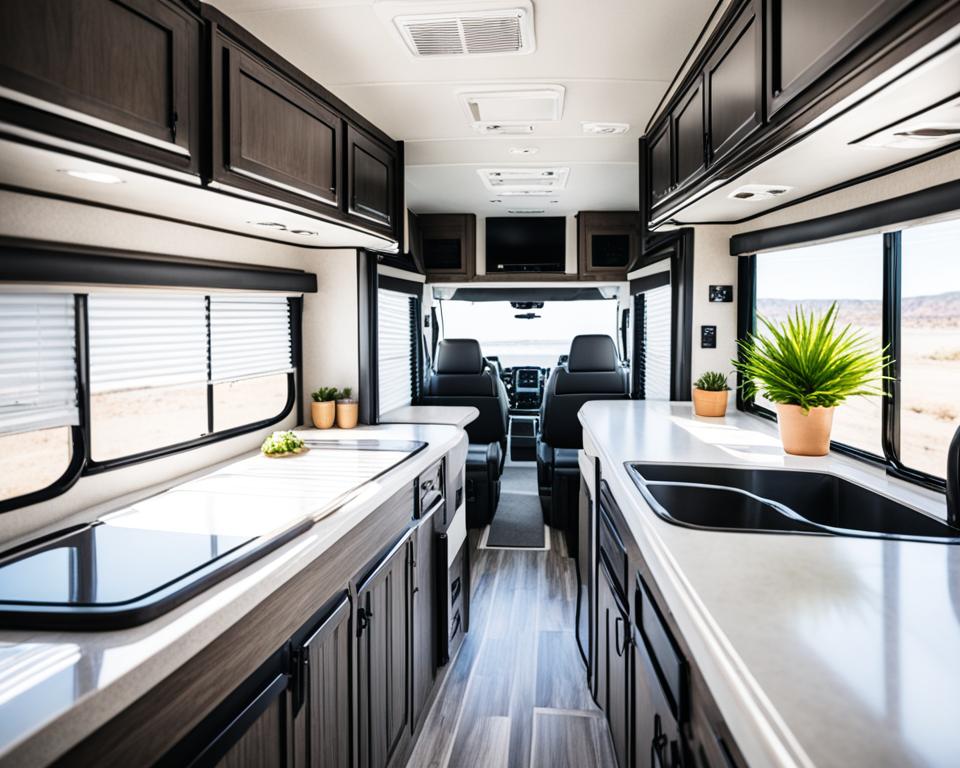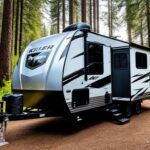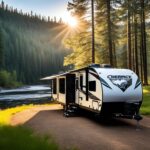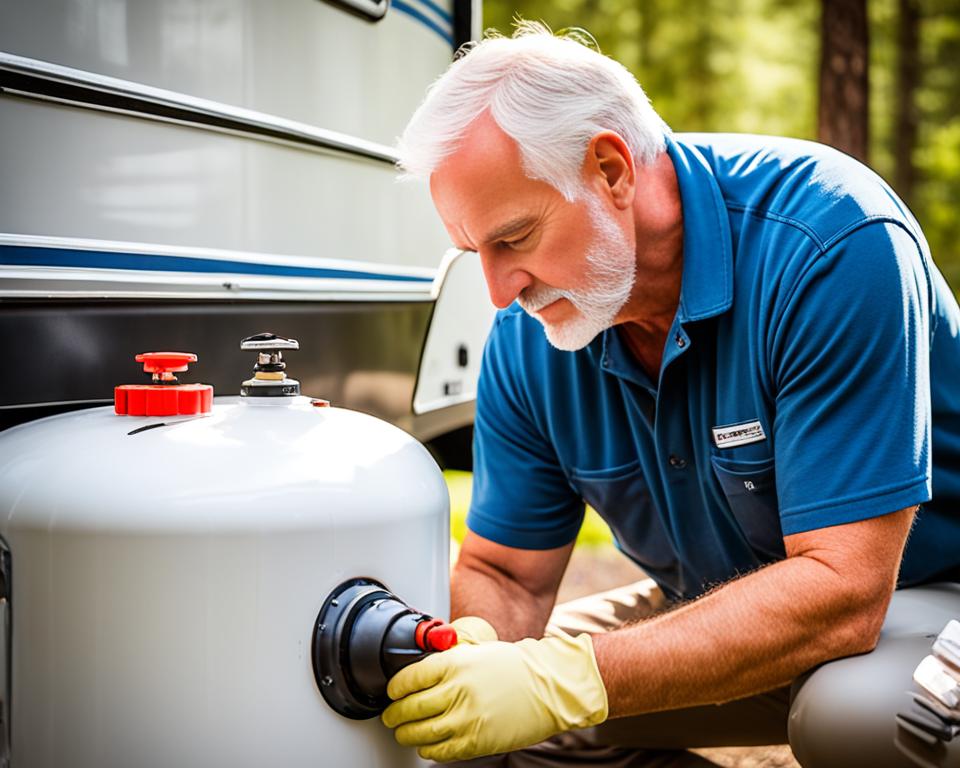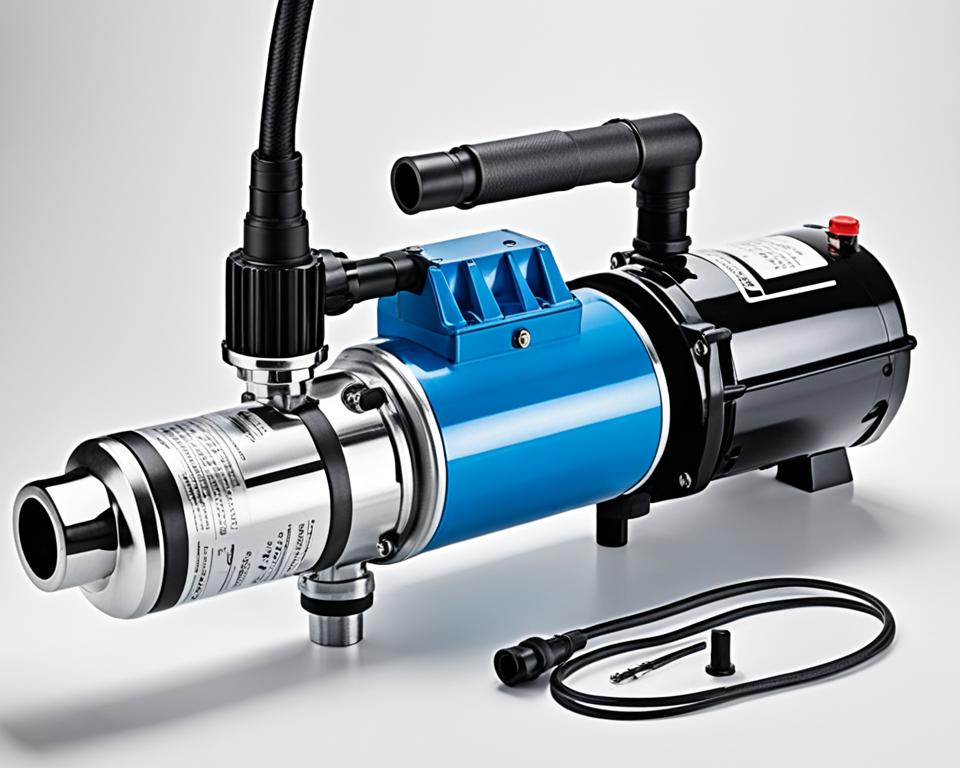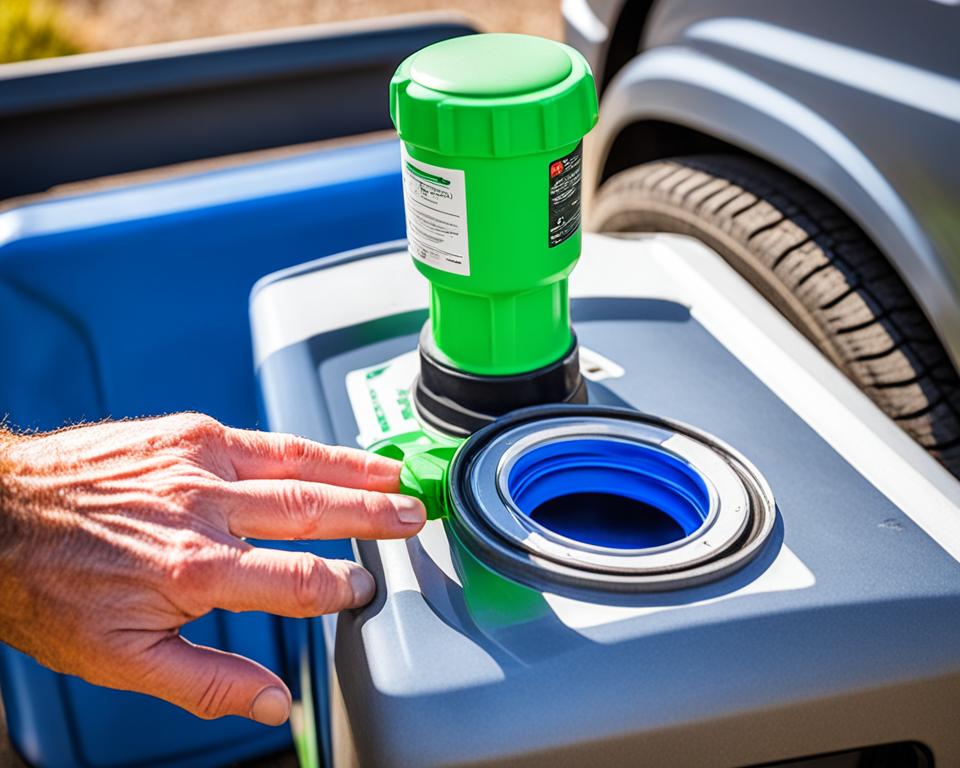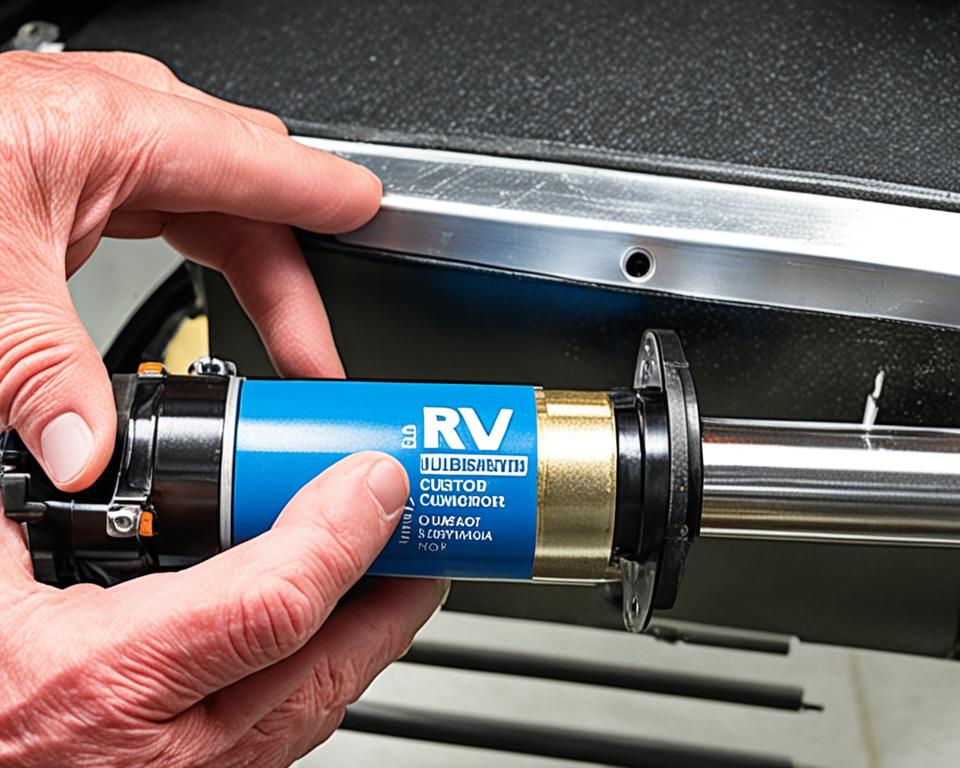Mold can be a common issue in RVs, especially during storage. Mold growth is caused by mold spores that find a moist, dark place to grow, and RVs are particularly prone to this because they are often closed up and stored for long periods of time. Moisture and lack of airflow are the primary causes of mold, so it’s crucial to take steps to prevent it. In this article, we will explore effective methods for preventing mold in RV interiors and keeping your home-on-wheels fresh and mold-free.
Key Takeaways:
- Regularly inspect your RV for signs of moisture or mold.
- Use dehumidifiers to remove excess moisture from the air.
- Consider storing your RV in an indoor facility for better protection against moisture.
- Properly maintain your fresh water systems by draining and blowing out water lines before storage.
- Use a proper cover for your RV that is waterproof and offers UV protection.
Understanding How Mold Forms in RVs
Mold is a common problem in RVs, and understanding how it forms is key to preventing its growth. Mold forms when mold spores, which are naturally present in the environment, find a moist and dark environment to thrive. RVs provide an ideal breeding ground for mold due to their frequent closure and storage for extended periods of time.
When moisture is present in an RV, whether from leaks, condensation, or high humidity, it creates the perfect conditions for mold to develop. Mold can be found on various surfaces within the RV, such as walls, carpet, and flooring. However, one of the easiest ways to identify mold is through its distinct musty smell.
Identifying mold in RVs is crucial, as exposure to mold can lead to respiratory issues and other health problems. Regular inspections can help you catch mold growth early and take necessary actions to address it.
- Poor ventilation: Lack of proper airflow and ventilation in closed RVs can contribute to moisture accumulation, creating an environment favorable for mold growth.
- Water leaks: Any water leaks or plumbing issues can introduce moisture into the RV, leading to mold growth if not promptly addressed.
- High humidity: RVs in humid climates or areas with high humidity levels are more susceptible to mold growth.
- Poor maintenance: Neglecting regular cleaning and maintenance routines can allow dirt, dust, and moisture to build up, providing an ideal environment for mold spores to thrive.
By understanding how mold forms and the common causes of mold in RVs, you can take proactive steps to prevent its growth. Regular inspections and maintenance, as well as implementing proper ventilation and humidity control measures, are essential in maintaining a mold-free environment in your RV.
Inspecting Your RV Before Storage
Before storing your RV, it’s crucial to conduct a comprehensive inspection of both the interior and exterior. This inspection will help you identify any damage or moisture that needs to be addressed before storage, minimizing the risk of mold growth. Paying particular attention to the plumbing system is essential in ensuring a mold-free RV environment.
Interior Inspection
1. Check for Signs of Damage: Inspect the interior of your RV for any signs of damage, such as cracks, leaks, or water stains on walls and ceilings. These may indicate areas where moisture can enter and contribute to mold growth.
2. Look for Visible Moisture: Scan all surfaces, including walls, floors, and furniture, for any signs of moisture or dampness, as these are ideal conditions for mold to thrive. Take note of any areas that feel wet or have a musty odor.
3. Inspect the Plumbing System: Focus on the plumbing system, including toilets, sinks, and showers. Check for any visible leaks or signs of water damage around these areas. Leaking pipes can lead to moisture buildup and mold growth if left unaddressed.
Exterior Inspection
1. Check the Roof: Examine the roof for any signs of damage, such as cracks, loose seals, or missing shingles. A damaged roof can allow water to seep into your RV, leading to mold growth.
2. Inspect Seals and Windows: Ensure that all seals and windows are intact and properly sealed. Damaged seals can allow water to enter your RV, creating an environment conducive to mold development.
3. Look for Exterior Leaks: Check for any signs of leaks, such as water stains or discoloration on the exterior walls. These may indicate areas where water can penetrate and cause moisture-related issues.
By thoroughly inspecting your RV before storage and addressing any issues promptly, you can maintain a mold-free environment and ensure your RV stays in optimal condition.
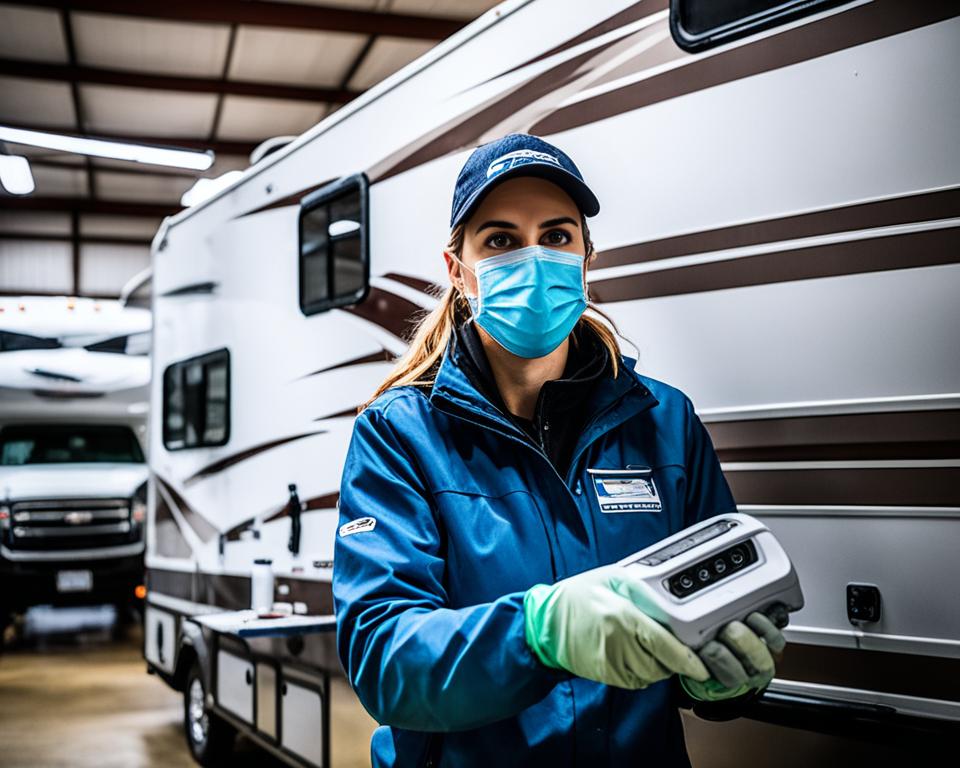
Using Dehumidifiers for Mold Prevention
Dehumidifiers are indispensable tools for preventing mold in RVs. Excess moisture is the main culprit behind mold growth, making it crucial to tackle this issue head-on. By running a dehumidifier in your RV before storage, you can effectively remove the excess moisture from the air, reducing the chances of mold development.
It is recommended to run the dehumidifier for a few hours or even a few days, especially with the RV or camper closed, to prevent additional moisture from getting in. This strategy helps create a dry and mold-resistant environment within your RV, protecting it during storage.
If your storage spot provides an electrical hookup, consider using a small dehumidifier while your RV is in storage. This ensures continuous moisture control, further minimizing the risk of mold growth.
Dehumidifiers offer several key benefits for mold prevention in RVs:
- Maintaining optimal humidity levels: Dehumidifiers regulate humidity levels, keeping them low and preventing conditions that are conducive to mold growth.
- Removing excess moisture: Removing excess moisture from the air helps eliminate the moisture source that molds need to thrive.
- Preventing musty odors: By reducing moisture, dehumidifiers can help eliminate the musty smell that often accompanies mold growth.
- Protecting your belongings: Mold can damage your RV interior, including furniture, upholstery, and other personal items. Using a dehumidifier helps safeguard your belongings from mold-related deterioration or discoloration.
By incorporating dehumidifiers into your mold prevention strategy, you’ll create a healthier and more comfortable environment in your RV, minimizing the risk of mold growth and ensuring a fresh and mold-free living space.
| Benefits of Using Dehumidifiers in RVs |
|---|
| Maintain optimal humidity levels |
| Remove excess moisture |
| Prevent musty odors |
| Protect belongings from mold damage |
Choosing Indoor Storage for Mold Prevention
When it comes to protecting your RV from mold, choosing the right storage option is crucial. While outdoor storage may be more common, opting for indoor storage offers numerous benefits that help safeguard your beloved vehicle from rain, condensation, and other moisture-related issues.
Indoor RV storage provides a controlled environment that shields your RV from the elements, including rain, dew, fog, and everyday condensation. This significantly reduces the risk of mold growth, a common problem in damp conditions. By keeping your RV safely sheltered indoors, you can prevent moisture from seeping into the interior and causing mold to thrive.
Investing in indoor storage may require a slightly higher budget compared to outdoor options, but the peace of mind and added protection it offers make it worthwhile. With indoor storage, you can have confidence that your RV is shielded from the unpredictable weather conditions that can pose a threat to its condition and value.
Pro Tip: Look for storage facilities that specialize in indoor RV storage options. These facilities are equipped with advanced climate control systems that maintain optimum temperature and humidity levels to prevent mold growth.
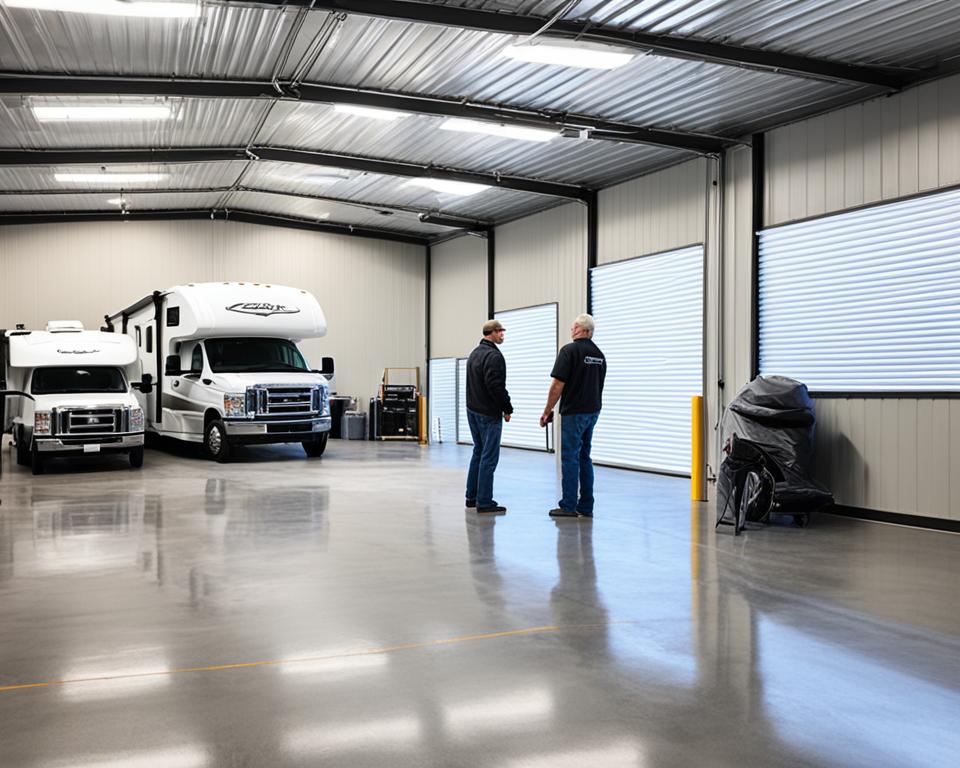
By choosing indoor storage for your RV, you can enjoy the following benefits:
- Protection from rain, dew, and condensation
- Prevention of mold growth
- Preservation of your RV’s condition and value
- Peace of mind knowing your RV is safely stored
When comparing storage options, keep in mind that the benefits of indoor storage extend beyond mold prevention. Indoor facilities often provide additional security measures, such as surveillance systems and controlled access, ensuring the safety of your RV from theft and vandalism.
“Indoor storage offers unparalleled protection for your RV, shielding it from the damaging effects of rain and condensation. By keeping your RV in a controlled environment, you can enjoy a mold-free interior and have peace of mind knowing your investment is well-protected.”
In summary, choosing indoor storage for your RV is an effective measure to prevent mold growth and protect your investment. It provides a controlled environment that shields your RV from rain, condensation, and other moisture-related issues. Look for storage facilities that specialize in indoor RV storage options to ensure maximum protection.
Maintaining Fresh Water Systems
Proper maintenance of fresh water systems is crucial for preventing mold growth in your RV. Neglecting this important aspect can lead to costly repairs and health hazards. By following a few simple steps, you can ensure your fresh water systems stay clean and mold-free.
Drain the Freshwater Tanks and Plumbing Lines
Before storing your RV, it’s essential to thoroughly drain all the freshwater tanks and plumbing lines. Any residual water left in the system can become a breeding ground for mold. Begin by turning off the water supply and opening all faucets to release any remaining pressure. Then, open the drain valves or plugs on the freshwater tanks to empty them completely.
Tip: To fully empty the water lines, consider using an air compressor. Connect the air compressor to the RV’s city water hookup and blow out the water lines until no more water comes out. This will ensure that there is no moisture left in the plumbing system.
Use Desiccants to Absorb Moisture
In addition to draining the fresh water systems, using desiccants designed for RVs can help absorb excess moisture from the environment. Desiccants are powerful drying agents that prevent the growth of mold and mildew by reducing humidity levels. Place desiccant pouches strategically throughout your RV, paying careful attention to areas prone to moisture, such as closets, cabinets, and storage compartments.
Regularly Inspect and Clean the Fresh Water Systems
To maintain the integrity of your fresh water systems, it’s important to inspect them regularly for any signs of damage, leaks, or contamination. Check for cracked or damaged pipes, loose fittings, and worn-out seals. If you detect any issues, address them promptly to prevent further damage and potential mold growth. Clean your freshwater tanks and lines using RV-specific sanitizing products to eliminate any residual bacteria or mold spores.
| Steps for Maintaining Fresh Water Systems in Your RV |
|---|
| 1. Drain the freshwater tanks and plumbing lines completely. |
| 2. Use an air compressor to blow out water lines and remove any remaining moisture. |
| 3. Place desiccant pouches in moisture-prone areas to absorb excess moisture. |
| 4. Regularly inspect and clean the fresh water systems for any damage, leaks, or contamination. |
By taking these preventive measures, you can ensure that your fresh water systems remain mold-free, promoting a healthy and enjoyable RV experience.
Protecting Your RV with a Proper Cover
If you can’t store your RV indoors, using a RV cover is an excellent way to protect it from mold and mildew. When choosing a cover, there are a few key factors to consider.
- Waterproof: Look for a cover that is waterproof from the outside. This will prevent moisture from seeping into your RV and creating an ideal environment for mold growth.
- UV Protection: UV rays from the sun can damage the seals around your RV’s windows and doors, making it easier for moisture to enter. Make sure the cover you choose offers UV protection to keep your RV safe.
- Ventilation: Opt for a cover that allows water vapor to vent from your RV. This will prevent excess moisture from building up inside the cover and reduce the risk of mold and mildew.
Before storing your RV, it’s important to take a few additional steps to prevent mold growth. Remove all fabrics from the vehicle, such as curtains, cushions, and linens. Fabrics tend to hold onto moisture and can become a breeding ground for mold and mildew.
By using a proper RV cover and taking these precautionary measures, you can protect your RV from mold and enjoy your adventures worry-free.
| Benefits of a Proper RV Cover | Prevention Tips |
|---|---|
| 1. Protects RV from moisture and rain | 1. Choose a waterproof cover |
| 2. Guards against UV damage | 2. Select a cover with UV protection |
| 3. Prevents mold and mildew growth | 3. Ensure proper ventilation in the cover |
Promoting Air Circulation in Your RV
Proper air circulation is crucial for preventing mold in RVs. When your RV is in storage, it’s important to take steps to promote air circulation and reduce moisture. This section will explore some effective methods to achieve this.
Opening Windows and Vents
One way to promote air circulation in your RV is by opening windows, closets, cupboards, and roof vents. By doing so, you allow fresh air to flow inside, helping to prevent trapped moisture and encouraging drying. This simple step can go a long way in preventing mold growth in your RV.
“Opening windows, closets, cupboards, and roof vents allows fresh air to flow inside, preventing trapped moisture and encouraging drying.”
Using Fans for Air Circulation
Another effective method is to use fans for air circulation. Place fans strategically throughout your RV, focusing on areas that tend to have higher humidity levels, such as the bathroom and kitchen. Running fans at regular intervals helps to circulate air and prevent stagnant, moist conditions that can lead to mold growth.
“Placing fans strategically throughout your RV and running them at regular intervals helps to circulate air and prevent stagnant, moist conditions.”
Wiping Down Surfaces
Before storing your RV, it’s essential to wipe down all surfaces to remove any moisture. Even the smallest amount of moisture can promote mold growth over time. Pay extra attention to areas where moisture tends to accumulate, such as the bathroom, kitchen, sink, and countertops. Use a clean, dry cloth to wipe down these surfaces thoroughly.
“Wiping down surfaces, particularly in moisture-prone areas, removes any residual moisture that could contribute to mold growth.”
By implementing these practices, you can effectively promote air circulation in your RV and minimize the risk of mold growth during storage.
Next, we’ll explore the importance of regular inspections and maintenance in preventing mold in your RV.
Regular Inspections and Maintenance
Regular inspections play a crucial role in preventing mold in your RV. It is recommended to visit your storage facility at least once a month to visually inspect your RV for any signs of moisture or mold. During your inspection, pay close attention to areas where water can accumulate, such as around windows, doors, and plumbing fixtures. Look for any signs of leaks or cracks that may allow moisture to enter your RV.
An effective way to detect mold presence is by smelling the air inside your RV. If you notice a musty odor, it could indicate the presence of mold. In addition to visual inspections and odor assessment, consider obtaining moisture packets designed for RVs and replace them as needed to maintain optimal moisture levels.
To further prevent mold growth, it is advisable to use heaters, fans, or dehumidifiers during your visit to the storage facility. These devices help regulate the humidity levels inside your RV, reducing the risk of mold development. Running a dehumidifier for a few hours can help remove excess moisture from the air, while heaters and fans promote air circulation, preventing stagnant air that can contribute to mold growth.
If you find any leaks or exterior cracks during your inspection, it is essential to address them promptly. Repairing leaks and sealing cracks will prevent moisture from entering your RV, reducing the likelihood of mold formation. By conducting regular inspections and performing necessary maintenance, you can ensure a mold-free environment and prolong the lifespan of your RV.
| Inspection Checklist |
|---|
| Visually inspect RV for signs of moisture or mold |
| Smell the air inside for a musty odor |
| Replace moisture packets as needed |
| Run a dehumidifier, heater, or fan during your visit |
| Check for leaks and cracks and address them promptly |
Conclusion
Taking the necessary steps to prevent mold in your RV is crucial for maintaining a healthy and mold-free environment. By regularly inspecting your RV, using dehumidifiers, choosing indoor storage, maintaining fresh water systems, using proper covers, promoting air circulation, and conducting regular maintenance, you can minimize the risk of mold growth. Keep your RV fresh and mold-free to ensure a safe and enjoyable experience on the road.
Regular inspections are key to preventing mold in your RV. Make it a habit to visit your storage facility at least once a month and visually inspect your RV for any signs of moisture or mold. The musty odor is an early indicator of mold presence, so be sure to give it a sniff. Replace moisture packets as needed and consider running a dehumidifier, heater, or fan for a few hours during your visit. Address any leaks or exterior cracks promptly to prevent moisture from entering your RV.
Choosing indoor storage for your RV is a wise choice when it comes to mold prevention. While it may be a bit more expensive, indoor storage provides better protection against rain, dew, fog, and everyday condensation, reducing the risk of mold growth. If indoor storage is not an option, consider using a waterproof and UV-protected cover that allows for proper airflow to prevent mold and mildew. Remember to remove all fabrics from your RV before storage, as they tend to hold onto moisture and can become a breeding ground for mold and mildew.
FAQ
How does mold form in RVs?
Mold forms in RVs when mold spores, which are naturally present in the environment, find a moist, dark environment to grow. RVs provide an ideal breeding ground for mold due to their frequent closure and storage for extended periods of time.
How can I identify mold in my RV?
Mold can be seen on the walls, carpet, and flooring of an RV, but the easiest way to detect it is through its musty smell. Mold can cause respiratory issues if left untreated, so it’s important to identify and address it early.
What should I inspect in my RV before storage?
Before storing your RV, conduct a thorough inspection of both the interior and exterior. Look for any signs of damage or the presence of moisture, and if any issues are identified, fix them before storage. Pay particular attention to the plumbing, checking for leaks around toilets and sinks.
How can dehumidifiers help prevent mold in RVs?
Dehumidifiers are effective tools for preventing mold in RVs. Moisture is the enemy when it comes to mold, so running a dehumidifier in your RV before storage can help remove excess moisture from the air.
Should I choose indoor storage for my RV to prevent mold?
One of the best ways to prevent mold in your RV is by storing it in an indoor storage unit. Indoor storage protects your RV from rain, dew, fog, and everyday condensation, reducing the risk of mold growth.
How can I maintain the fresh water systems in my RV to prevent mold?
To prevent mold growth, it’s important to properly maintain the fresh water systems in your RV. Before storing your RV, thoroughly drain all freshwater tanks and plumbing lines. Any water left in the system can increase the risk of mold.
Can using a proper cover protect my RV from mold?
If you can’t store your RV indoors, using a proper RV cover can help protect it from mold and mildew. Look for a cover that is waterproof from the outside and allows water vapor to vent from the RV.
How can I promote air circulation in my RV to prevent mold?
Proper air circulation is crucial for preventing mold in RVs. When your RV is in storage, open windows, closets, cupboards, and roof vents to allow air to flow inside. This helps to prevent trapped moisture and encourages drying.
How often should I inspect my RV for mold?
Regular inspections are key to preventing mold in your RV. Visit your storage facility at least once a month and visually inspect your RV for any signs of moisture or mold. Smell the air inside your RV, as a musty odor can indicate mold presence.
What are some additional tips for preventing mold in RVs?
Taking the necessary steps to prevent mold in your RV is crucial for maintaining a healthy and mold-free environment. By regularly inspecting your RV, using dehumidifiers, choosing indoor storage, maintaining fresh water systems, using proper covers, promoting air circulation, and conducting regular maintenance, you can minimize the risk of mold growth.

